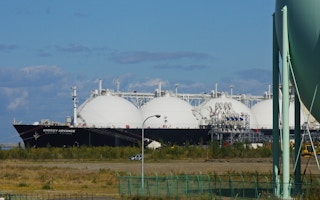Gas importers in Japan will have to find new customers abroad to offload excess domestic supply this decade, a move that will cause financial risks for the country’s largest utilities and worsen climate and energy challenges for its Southern neighbours, according to a report by the Institute for Energy Economics and Financial Analysis (IEEFA)
To continue reading, subscribe to Eco‑Business.
There's something for everyone. We offer a range of subscription plans.
- Access our stories and receive our Insights Weekly newsletter with the free EB Member plan.
- Unlock unlimited access to our content and archive with EB Circle.
- Publish your content with EB Premium.
Japan’s largest utilities could have 11 million tonnes more liquefied natural gas (LNG) per year than needed through to 2030, due to the scale-up of nuclear and renewable power generation in the country, a declining population and slow economic growth, the United States-based think tank said.
As a result, gas buyers in what used to be a major import destination “are cultivating demand in emerging Asia to offload surplus LNG volumes, a move that aligns with the Japanese government’s energy trading goals, IEEFA’s report on Monday added.
Interest in natural gas has been climbing across Asia, as a “transition” fuel to help move away from more pollutive coal power before cleaner renewable power is available en masse. Critics say natural gas still produces too much carbon emissions, and also blocks faster scale-up of solar and wind generation.
The IEEFA report noted that major utilities are investing in projects such as regasification terminals and gas power plants, particularly in South and Southeast Asia.
It zoomed in on four companies – JERA, Tokyo Gas, Kansai Electric and Osaka Gas – which account for almost three-quarters of Japan’s historical contracting activity. Compiled data showed that these firms have contracted more LNG supply than needed for most years from 2019 to 2030, with excess in 2022 and 2023 at roughly 2 to 3 million tonnes per year. Their exports have also increased multifold from a low base in 2017.
Overall, LNG sales by Japanese companies to other countries rose from about 15 million tonnes in 2018 to over 38 million tonnes in 2021, based on government data.
IEEFA also noted that JERA and Tokyo Gas are involved in dozens of LNG-fired power plants, import terminals, and supply infrastructure projects in Southeast Asia, Bangladesh and Taiwan. Meanwhile, Osaka gas participates in regional gas distribution and technical services. Kansai Electric has a trading firm in Singapore, along with minority stakes in regional power plants.
Sam Reynolds, Asia LNG and gas research lead at IEEFA, said Japanese gas trade activity in Southeast Asia “could lock in energy insecurity for these emerging economies for decades to come”, citing geopolitical, climate and infrastructure risks.
“This unreliability has been repeatedly demonstrated over the past four years, as emerging markets relying on LNG have faced recurring gas shortages, electricity outages, economic disruptions, and financial challenges,” Reynolds told Eco-Business. Gas prices worldwide spiked in 2021 and 2022 following a post-pandemic economic boom and Russia’s invasion of Ukraine that fractured supply routes.
Greater LNG supply from Japan could ease prices for the rest of Asia, but Reynolds said market trends can still “change on a dime”. Methane emissions from gas facilities could have an outsized climate impact, and increase the risk of asset stranding as decarbonisation pressures increase, he added.
The export boom could impact Japanese players too. IEEFA’s report said their overseas LNG sales are likely to coincide with a global gas supply boom, causing prices to fall and profit margins to collapse.
Responding to Eco-Business queries, Kansai Electric said its LNG procurement is based on a variety of factors concerning its portfolio, flexibility and demand and could not comment on energy or environmental issues in Southeast Asia.
Tokyo Gas declined to comment, while Osaka Gas and JERA have not responded.
The Japanese government has a LNG transaction target of 100 million tonnes per year by 2030, part of which includes export to its Asian neighbours. Domestically, LNG power is expected to fall by over half by 2030, as part of the nation’s decarbonisation plans. Gas currently accounts for a third of Japan’s power supply.
Japan’s LNG imports have been falling over the years, but it remains a major buyer, ranking just behind China in 2023. Japanese firms have since 2022 secured long-term deals from suppliers in Australia and the United States for over 5 million tonnes of LNG per year, according to news agency Reuters.
“Understanding the drivers for Japan’s LNG push in Southeast Asia is key to seeing past the sales pitch,” Reynolds said, adding that new LNG projects should be assessed on a “strict case-by-case basis” rather than permitting a “wholesale buildout”.
Currently, about a third of Southeast Asia’s power generation capacity, of around 100 gigawatts, comes from natural gas plants. Gas power capacity is expected to stay roughly constant through to 2050 under ambitious climate scenarios, or more than double in a business-as-usual situation, according to a 2022 report by the Asean Centre for Energy.
The region is also looking to expand its own gas production after years of slow decline. Meanwhile, the region is just shy of its target of renewables contributing 35 per cent of its installed capacity by 2025, though slow construction could get in the way.

















